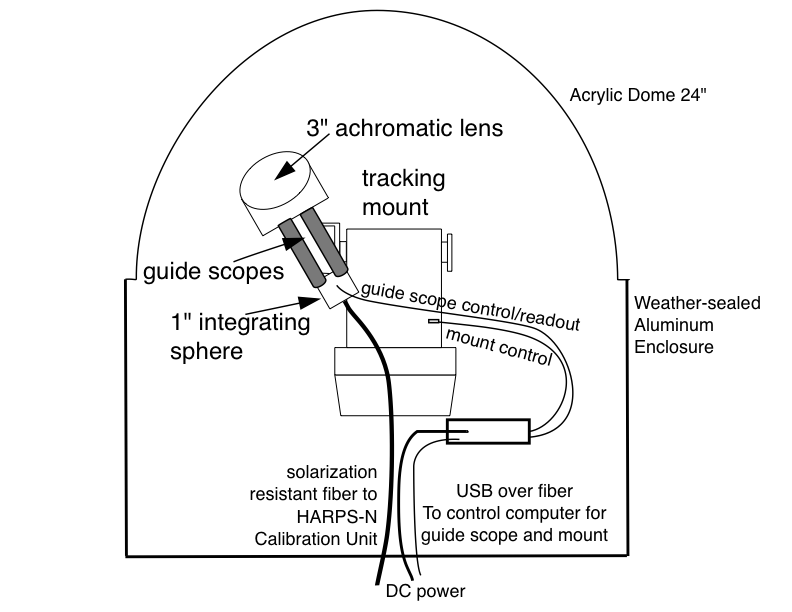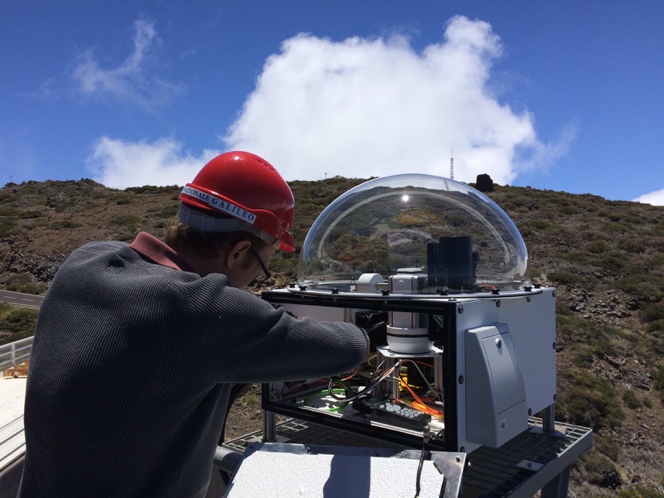Watching for the next solar cycle with the HARPS-N solar telescope
Stellar magnetic activity is the bane of planet-hunters’ lives. Radial-velocity spectrometers such as HARPS-N are capable of monitoring the periodic Doppler wobbles of bright solar-type stars to a precision better than 40 cm s–1. To achieve this on a repeatable basis over timescales of years is a challenge that requires deep understanding of the instrument and the detector. Since HARPS-N’s inception, David Phillips’ team at CfA have used a laser frequency comb to monitor the instrumental profile and provide a fundamental wavelength reference for the ThAr and Fabry-Perot calibration sources that monitor instrumental drift.
The host stars of the super-Earths and mini-Neptunes that HARPS-N observers seek to characterise are, however, anything but stable. Starspots and faculae are carried across the visible hemispheres of rotating stars, blocking Doppler-shifted light and altering the convective patterns that define the shapes of spectral lines. Sparsely sampled, these effects combine to produce an apparent additional source of radial-velocity scatter. In reality, we are seeing time-correlated variability with amplitudes ranging from one or two m s-1 from photospheric convection on hours timescales, to several m s–1. on the weeks timescale of the stellar rotation and the decade-long timescale of the activity cycle.


Figure : (Left) Schematic of the solar telescope consisting of 3” lens and integrating sphere along with guide cameras, mount, control electronics, and enclosure. (Right) Photograph of telescope in its enclosure being installed at the TNG. (Credits: David Phillips)
To combat these correlated stellar-noise contributions requires an observing strategy dictated by the power spectrum of the host star’s variations. Shortly after the start of HARPS-N operations, Xavier Dumusque (then at CfA) and David Phillips conceived and built a low-cost solar-telescope feed for HARPS-N. Consisting of a 3-inches (7.6 cm!) telescope and integrating sphere on a guided mount inside a transparent dome, the solar telescope has been feeding sunlight into HARPS-N with a cadence of 5 minutes (to average out solar p-modes) during all clear daytime hours since mid-2015. Its operation is almost completely robotic – indeed it kept operating throughout the February 2020 calima event and the COVID-19 closure of the TNG for night-time observing 24 March to 24 April 2020.

Figure shows the solar radial velocity at full 5-minute cadence, corrected for barycentric motion and differential extinction. The 2020 Calima and COVID-19 events are shown by brown and red bars respectively. (Credits: Andrew Collier Cameron)
When the measured velocities are transformed to the heliocentric frame, the Sun becomes the only star we can study which is free of planetary reflex motion. Its radial velocity curve since mid-2015 shows quasi-periodic variations on the 27-day solar rotation period during the declining two years of the last solar cycle. Since early 2018, the Sun has been quiet, with only sporadic active-region passages seen in late 2018 and the first half of 2019. Throughout the extended solar minimum, the mean solar radial velocity has crept upwards by about 2 m/s, with an apparent ~300-day oscillation of unknown origin superposed. Uncorrected, such trends and quasi-periodicities could lead to false-positive detections in low-mass planet searches.
The HARPS-N team are continuing to gather solar data and study the 80,000 spectra from which these velocities were derived, looking for the spectral fingerprints of the processes that cause these apparent velocity shifts. The HARPS-N solar spectra are a valuable resource for developing proxy indicators of activity-driven RV shifts that must be applied to other stars, as the search for low-mass exoplanets in long-period orbits continues. The public release of the first 3 years of HARPS-N data products, reprocessed with the state-of-the-art ESPRESSO data pipeline, is scheduled for the solar telescope’s 5th birthday in July 2020.
The public release of all the spectra and other pipeline data products from the first three years of HARPS-N solar telescope operation, reprocessed with the state-of-the-art ESPRESSO data pipeline, is scheduled for the solar telescope’s 5th birthday in July 2020. For more information, see: https://plone.unige.ch/HARPS-N/harps-n-operations-and-observations/harps-n-solar-telescope-data-release
More information on the instrument is published at https://doi.org/10.1117/12.2232452 and https://arxiv.org/abs/1511.02267, on the first 3 years of RV measurements at https://arxiv.org/abs/1904.12186, and on interpretation of the data at https://arxiv.org/pdf/1902.04184 and https://arxiv.org/abs/2004.09830.

